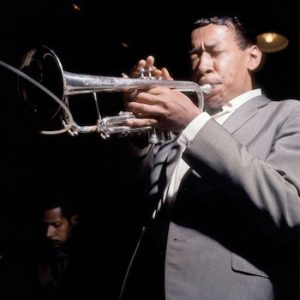
Lee Morgan
*Lee Morgan was born on this date in 1938. He was a Black jazz trumpeter and composer.
Edward Lee Morgan was born in Philadelphia, Pennsylvania, the youngest of Otto Ricardo and Nettie Beatrice Morgan's four children. Originally interested in the vibraphone, he soon grew enthusiastic about the trumpet. Morgan also knew how to play the alto saxophone. On his thirteenth birthday, his sister Ernestine gave him his first trumpet. His primary stylistic influence was Clifford Brown, with whom he took a few lessons as a teenager.
Morgan recorded prolifically from 1956 until a day before his death. He joined Dizzy Gillespie's Big Band at 18 and remained a member for a year and a half until economic circumstances forced Gillespie to disband the unit in 1958. Morgan began recording for Blue Note in 1956, eventually recording 25 albums as a leader for the label. He also recorded on the Vee-Jay label and one album for Riverside Records on its short-lived Jazzland subsidiary. He was a featured sideman on several early Hank Mobley records and intermittently afterward. On John Coltrane's only Blue Note album as a leader, Blue Train (1957), he played the trumpet with an angled bell (given to him by Gillespie).
Joining Art Blakey's Jazz Messengers in 1958 further developed his talent as a soloist and composer. He toured with Blakey for a few years and was featured on numerous albums by the Messengers, including Moanin', one of the band's best-known recordings. When Benny Golson left the Jazz Messengers, Morgan persuaded Blakey to hire Wayne Shorter, a young tenor saxophonist, to fill the chair. During his time with The Jazz Messengers, Morgan wrote several tunes, including The Midget, Haina, Celine, Yama, Kozo's Waltz, Pisces, and Blue Lace. The drug problems of Morgan and Timmons forced them to leave the band in 1961, and the trumpeter returned to Philadelphia, his hometown.
One of the key hard-bop musicians of the 1960s, Morgan stayed with Blakey until 1961 and started to record as a leader soon after. His song "The Sidewinder," on the album of the same name, became a surprise crossover hit on the pop and R&B charts in 1964, while Morgan's recordings found him touching on other styles of music as his artistry matured. Soon after The Sidewinder was released, Morgan rejoined Blakey briefly. After leaving Blakey for the final time, Morgan continued to work prolifically as both a leader and a sideman, becoming a cornerstone of the Blue Note label. According to Morgan biographer Tom Perchard, Blakey introduced the trumpeter to heroin, which impeded his progression in his career.
Morgan was killed in the early hours of February 19, 1972, at Slugs' Saloon, a jazz club in New York City's East Village where his band was performing. Following an altercation between sets, Morgan's common-law wife, Helen Moore, shot him. The injuries were not immediately fatal, but the ambulance arrived slowly as the city experienced heavy snowfall, resulting in tough driving conditions. They took so long to get there that Morgan bled to death. He was 33 years old. Helen Morgan was arrested and spent a short time in prison before being released on parole. After her release, she returned to her native North Carolina and died from a heart condition in March 1996. Lee and Helen Morgan were the subjects of a 2016 documentary, I Called Him Morgan.